How can archaeology students develop themselves to become underwater archaeologists; pragmatically if there are no underwater archaeology field-school courses or programs that are taught in their universities or even in their countries? This is the question that I always asked myself when I was a student of the Faculty of Archaeology, Silpakorn University, Thailand.
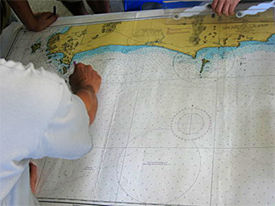
Locating the site on the map.
Every summer break, students who are interested in diving and would like to discover new valuable knowledge of maritime archaeology gather attentively together to set up a project to learn diving with skillful archaeologists and aquanauts who work at the Underwater Archaeology Division, Fine Arts Department, Chantaburi province, Thailand. Knowing how to be a good diver only is not enough to facilitate working under water practically; a group of students then gathers again to find a way to explore real maritime fieldwork. Instead of a course that gives credits, their endeavors appear in the form of students’ activity projects during the semester break.
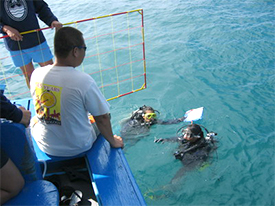
Students taking a grid to the bottom at the Hin Bush shipwreck site.
With the help of the Underwater Archaeology Division, the strong endeavor of the students and the advising professor for the project, the Underwater Archaeology Volunteer Training Project has taken place once again from October 24 – November 4, 2007 for the third time after 2000 and 2003. The project is based on sponsorship partly from kind private sector organizations, equipment from the underwater archaeology division and most importantly, the training by the professional underwater archaeologists and aquanauts of the Fine Arts Department. The aim of the volunteer training project so far is to broaden understanding of the curious students with new experience that is related to archaeology, thus creating a new generation of spectacular field professionals.
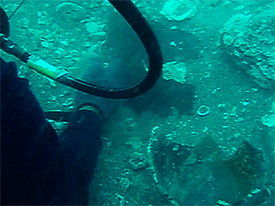
Hand-fanning the features.
Due to a limited budget and a convenient location for the training, the project was designed at Hin Bush Shipwreck site, Rayong province, which is about 3 hours from Bangkok, the capital city of Thailand. Hin Bush wreck site is not far from the shore. It takes only about an hour to get to the site. Furthermore, it is only about 10 meters (33 feet) deep which is good for novice diver students who do not have many diving hours, yet it is deep enough to develop their diving skills. In addition, the waterfront of Rayong is quite clear with visibility of 4-5 meters (12-15 feet) and the bottom is composed of white sand, not muddy.
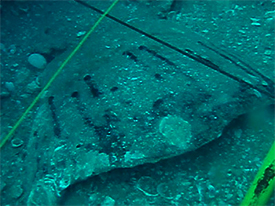
Pottery fragment in the test unit.
Hin Bush Shipwreck was first investigated in 1994 and then intricately excavated in 1994-1995 by the Underwater Archaeology Division with the assistance of volunteers. At the shipwreck site, many ancient pottery, ballast, small utensils like fishhooks, spears, and metal fasteners and the frames of a wooden junk were found. The pottery found at the site can be compared to the objects found in other on-land archaeological sites of Thailand that were the production sources of ancient famous pottery products. The products are also the same as the ones that were discovered at other interesting shipwrecks, such as Koh Sichang Shipwreck no.1, 2 and 3, and Samui Shipwreck. These kinds of pottery were very common around the seventeenth to eighteenth centuries, during the late Ayutthaya period of Thailand.
The previously mentioned field-school-like project allowed the students to practice the techniques and methodology used in maritime fieldwork. They learned the general theory and methods of maritime archaeology, the traditional panoramic sketching in order to locate the sites, underwater digging on the test unit, recording the features exposed in the test units, and about the other difficulties that were involved such as the nature of the sea. Even though it was a brief maritime field school practice at an already excavated site, the students gained a lot of perspective on how the process works underwater with many factors involved. They can see how it is different from the familiar terrestrial one.
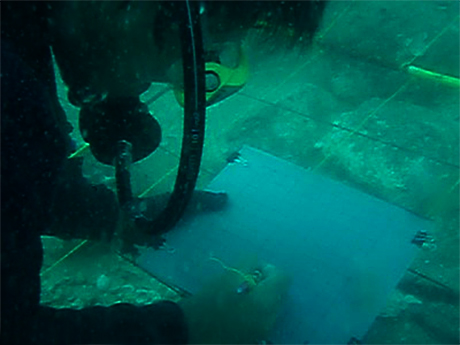
Drawing the features.
From this project, further courses could be developed for particular subjects for archaeology students in the near future, due to the need and interest of the modern society. Possibly, this site may be used as a practical site for future students for its various advantages. In addition to the precious skills they developed, some students may be inspired, which could further enhance their performance and interests later.
A wonderful example of success is that one former student from the underwater archaeology volunteer training project for the first time is now working in his dream field as an underwater archaeologist. Similarly, I first learned how to dive through the teaching of those experts. Later, since I finished university, I have been trying to explore international maritime archaeology more. Fortunately, I had the chance to participate in the maritime archaeology field school at the University of Western Florida last summer which gave me a lot of experience. I shared the methodology from the U.S. with young students and my first instructors when I joined this volunteer project recently. Finally, I hope that there will be more opportunities for the young to excavate our submerged cultural heritage, as we might luckily have an elective course in the university soon.
Comments, suggestions, or questions can be directed to mua@keimaps.com
Return to In The Field home page.





